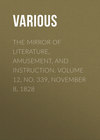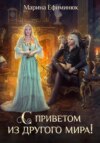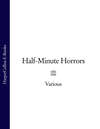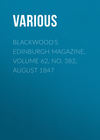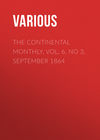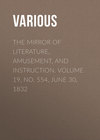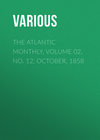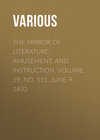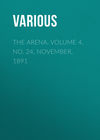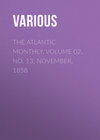Loe raamatut: «The Mirror of Literature, Amusement, and Instruction. Volume 12, No. 339, November 8, 1828», lehekülg 3
SPIRIT OF DISCOVERY
Aerial Voyages of Spiders
The number of the aëronautic spiders occasionally suspended in the atmosphere, says Mr. Murray, I believe to be almost incredible, could we ascertain their amount. I was walking with a friend on the 9th, and noticed that there were four of these insects on his hat, at the moment there were three on my own; and from the rapidity with which they covered its surface with their threads, I cannot doubt that they are chiefly concerned in the production of that tissue which intercepts the dew, and which, illuminated by the morning sun, "glitters with gold, and with rubies and sapphires." Indeed, I have noticed that, when the frequent descent of the aëronautic spider was determined, a newly rolled turnip field was, in a few hours, overspread by a carpet of their threads. It may be remarked that our little aëronaut is very greedy of moisture, though abstemious in other respects. Its food is perhaps peculiar, and only found in the superior regions of the sky. Like the rest of its tribe, it is doubtless carnivorous, and may subserve some highly important purpose in the economy of Providence; such, for instance, as the destruction of that truly formidable, though almost microscopically minute insect, the Fùria infernàlis, whose wounds are stated to be mortal. Its existence has been indeed questioned, but by no means disapproved; that, and some others, injurious to man, or to the inferior creation, may be its destined prey, and thus our little aëronaut, unheeded by the common eye, may subserve an important good.
Mr. Bowman, F.L.S. says, "We arrested several of these little aëronauts in their flight, and placed them on the brass gnomon of the sundial, and had the gratification to see them prepare for, and recommence, their aerial voyage. Having crawled about for a short time, to reconnoitre, they turned their abdomens from the current of air, and elevated them almost perpendicularly, supporting themselves solely on the claws of their fore legs, at the same instant shooting out four or five, often six or eight, extremely fine webs, several yards long, which waved in the breeze, diverging from each other like a pencil of rays, and strongly reflecting the sunbeams. After the insects had remained stationary in this apparently unnatural position for about half a minute, they sprang off from the stage with considerable agility, and launched themselves into the air. In a few seconds after they were seen sailing majestically along, without any apparent effort, their legs contracted together, and lying perfectly quiet on their backs, suspended from their silken parachutes, and presenting to the lover of nature a far more interesting spectacle than the balloon of the philosopher. One of these natural aëronauts I followed, which, sailing in the sunbeams, had two distinct and widely diverging fasciculi of webs, and their position in the air was such, that a line uniting them would have been at right angles with the direction of the breeze."—Mag. Natural History.
The Ichneumon Fly
There are several species of ichneumon which make thinnings among the caterpillars of the cabbage butterfly. The process of one species is this:—while the caterpillar is feeding, the ichneumon fly hovers over it, and, with its piercer, perforates the fatty part of the caterpillar's back in many places, and in each deposits an egg, by means of the two parts of the sheath uniting together, and thus forming a tube down which the egg is conveyed into the perforation made by the piercer of the fly. The caterpillar unconscious of what will ensue keeps feeding on, until it changes into a chrysalis; while in that torpid state, the eggs of the ichneumon are hatched, and the interior of the body of the caterpillar serves as food for the caterpillars of the ichneumon fly. When these have fed their accustomed time, and are about to change into the pupa state, they, by an instinct given them, attack the vital part of the caterpillar (a most wonderful economy in nature, that this process should be delayed until they have no more occasion for food.) They then spin themselves minute cases within the body of the caterpillar; and instead of a butterfly coming forth (which, if a female, would have probably laid six hundred eggs, thus producing as many caterpillars, whose food would be the cabbage,) a race of these little ichneumon flies issues forth, ready to perform the task assigned them, of keeping within due limits those fell destroyers of our vegetables.—Mr. Carpenter—in Gill's Repository.
Hawking
Professional falconers have been for many years natives of the village of Falconsward, near Bois le Duc, in Holland. A race of them was there born and bred, whence supplies have been drawn for the service of all Europe; but as there has been no sufficient inducement for the young men to follow the employment of their forefathers, numbers are dead or worn out; and there only remains John Pells, now in the service of John Dawson Downes, Esq., of Old Gunton Hill, Suffolk.
The hawks which have been trained for the field, are the slight falcon and the goshawk, which are the species generally used in falconry. The former is called a long-winged hawk, or one of the lure; the latter, a short-winged hawk, or one of the fist.
The Icelander is the largest hawk that is known, and highly esteemed by falconers, especially for its great powers and tractable disposition. The gyr falcon is less than the Icelander, but much larger than the slight falcon. These powerful birds are flown at herons and hares, and are the only hawks that are fully a match for the fork-tailed kite. The merlin and hobby are both small hawks and fit only for small birds, as the blackbird, &c. The sparrow-hawk may be also trained to hunt; his flight is rapid for a short distance, kills partridges well in the early season, and is the best of all for landrails.
The slight falcon takes up his abode every year, from October and November until the spring, upon Westminster Abbey, and other churches in the metropolis. This is well known to the London pigeon-fanciers, from the great havoc they make in their flight.—Sir John Sebright
Technicalities of Science
The inutility of science, written in a merely technical form, is well exemplified in the instance of Cicero. He was advised by his friends not to write his works on Greek Philosophy in Latin; because those who cared for it would prefer his work in Greek, and those who did not would read neither Greek nor Latin. The splendid success of his De Officiis, his De Finibus, his De Natura Deorum, &c., showed that his friends were wrong. He persevered in the popular style, and led the fashion.—Mag. Nat. Hist.
Doubtful Discoveries
It may serve, in some measure, to confirm M. Dutroehet's recent opinion of the non-existence of miscroscopic animalcula, that the celebrated Spallanzani persuaded himself that he could see Animálcula infusòria which could be seen by nobody else. He attributed his own superiority of vision, in this respect, to long practice in using the microscope. The philosopher exulted in his enviable distinction, when a peasant, to whom he showed his animalcula, could perceive nothing but muddy water.—Ibid.
Faculties of Brutes
The dog is the only animal that dreams; and he and the elephant the only animals that understand looks; the elephant is the only animal that, besides man, feels ennui; the dog, the only quadruped that has been brought to speak. Leibnitz bears witness to a hound in Saxony, that could speak distinctly thirty words.—Medical Gazette.
Sea Air
The atmosphere, in the vicinity of the sea, usually contains a portion of the muriates over which it has been wafted. It is a curious fact, but well ascertained, that the air best adapted to vegetables is pernicious to animal life, and vice versa. Now, upon the sea-coast, accordingly, animals thrive, and vegetables decline.—Hurwood's Southern Coast.
Chingford Church
The roof with moss is green, and twines
Dark ivy round the sculptur'd lines.
DELTA.
The pleasant village of CHINGFORD, in Essex, may be called a vignette of the topographer's "rus in urbe," it being only nine miles distant from the heart of London, and consequently almost within its vortex. It stands on the banks of the river Lea, and derives its name from the Saxon word Cing and ford, (signifying the king's ford,) there having formerly been a ford here; the adjoining meadows being designated the king's meads, and the Lea, the king's stream. There appears to have been two manors in this parish, one of which was granted by Edward the Confessor to the cathedral of St. Paul's, but surrendered at the reformation to Henry VIII.; the other, according to Domesday Book, was held by Orgar, the Thane; and from the latter another manor has since been taken.
The "ivy-mantled" church, represented in the above vignette, is dedicated to St. Peter and St. Paul, and consists of a chancel, nave, and south aisle, with a low square tower at the west end, containing three bells. Within the church are a few interesting monuments, among which is one to the memory of Robert Rampton, who died in 1585 and was yeoman of the chamber to Edward VI., and the Queens Mary and Elizabeth. It stands in the south aisle, with an inscription on a brass plate against the wall, underneath which is an altar tomb covered with a slab of black marble, on which are the effigies, in brass, of Robert Rampton, and his wife Margaret, who died in 1590.
Altogether, Chingford is one of the prettiest villages near London, and its church is a picturesque attraction for pedestrian tourists, and such as love to steal away from the maelstroom of an overgrown metropolis, to glide into scenes of "calm contemplation and poetic ease;" although much of the journey lies through avenues of bricks and mortar, and trim roads that swarm with busy toil.
In the parish of Chingford is an estate called Scots Mayhew, or Brindwoods, which is held of the rector by the following singular tenure:—"Upon every alienation, the owner of the estate, with his wife, and a man and maid servant, (each upon a horse) come to the parsonage, where the owner does his homage, and pays his relief in manner following:—He blows three blasts with his horn, carries a hawk on his fist, and his servant has a greyhound in a slip—both for the use of the rector that day. He receives a chicken for his hawk, a peck of oats for his horse, and a loaf of bread for his greyhound. They all dine, after which the master blows three blasts on his horn, and they all depart."5
For the original of the engraving, and the substance of this description, our thanks are due to S.I.B.
OLD SONG
The old minstrels saw far and deep, and clear into all heart-mysteries—and, low-born, humble men as they were, their tragic or comic strains strike like electricity.—Blackwood.
